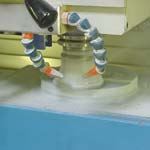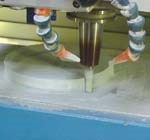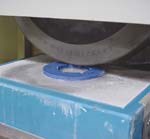Clamping Difficult Workpieces With Ice
What does a shop do with a workpiece that needs machining but can't be toe-clamped, bolted, chucked or held in a conventional vise? Securely holding many so called exotic materials - ceramics, carbides, glass, and other brittle blanks - is a challenge. The Ice Vice may offer a solution.
Share




What does a shop do with a workpiece that needs machining but can't be toe-clamped, bolted, chucked or held in a conventional vise? Securely holding many so called exotic materials—ceramics, carbides, glass, and other brittle blanks—is a challenge. Plus, many of these workpieces are asymmetrical in shape, further exacerbating the workholding challenge.
A system for holding the unholdable is what German manufacturer Horst Witte (Bleckede, Germany) demonstrated at IMTS in cooperation with its U.S. representative, Ibag North America (North Haven, Connecticut). Called the Ice Vise, this system uses the adhesive power of frozen water to securely hold workpieces that could be damaged using conventional methods or require very specialized fixturing because of their shapes.
Most who live in places where winters are cold know the adhesive power of frozen water. Seeing the rubber blade of a windshield wiper tear off its holder and remain affixed to the windshield on a cold morning is proof of ice's powerful grip.
The ice vise system has two main components: an external cooling unit and the freeze plate. An umbilical connects the freeze unit to the machine tool mounted plate. The freeze plate is designed to attach to the machine tool worktable like a subtable would.
In operation, a workpiece is placed on the previously cooled freeze plate. A thin film of water is sprayed onto the plate surface with the workpiece in place. The freeze plate is then activated, lowering the temperature of the water and its captive workpiece to -10º C and securing the work for processing.
Approximately 90 seconds later the workpiece is frozen solidly to the plate. The company says that -10º C seems to be the ideal temperature because the ice itself has not yet become brittle and cracked. Therefore, the maximum holding potential is realized at that temperature. The integrated electronics in the ice vise system maintain the temperature of the plate to ±2º C. Built-in sensors check the temperature constantly. To shorten clamping/unclamping cycles, which are about 90 seconds for each, a vacuum connection can be used to quickly position workpieces.
The system uses cold air, which is recirculated through the freeze plate, to quickly adhere the work to the surface. The air is fed in and compressed to a minimum of 6 bar pressure. The ice vise can be connected to any shop air supply. It is the movement of the air that cools the plate. Reversing the direction of the air results in the thawing cycle for releasing the work from the vise. The unit is designed to work with an ambient shop temperature of 20º C. Adjustments can be made for different ambient conditions.
Workholding is a challenge for any shop. Finding a cost effective method, short of specially built fixturing, to hold difficult workpieces is a goal for reducing costs. The ice vise is not a workholder for all parts, but it does possess the potential to solve some knotty workholding problems.
Applications that might benefit from this technology include brittle, fragile and asymmetrical blanks. Another advantage of using water in the device is that materials (for example honeycomb) that are difficult to hold because they present insufficient surface area to vacuum mount, can easily be held with an ice vise. The water tends to migrate into the pores of a honeycomb structure, providing additional surface area for holding and adding reinforcement to the fragile material.
Related Content
Fixturing Castings Made Simple Through Adhesive Workholding
When a casting proved too malleable for traditional gripping, Thomas/Euclid Industries adopted — and succeeded with — Blue Photon adhesive workholding.
Read MoreRail Manufacturer Moves Full Steam Ahead with Safe, Efficient Workholding Solution
All World Machinery Supply paired a hydraulic power unit with remote operating capabilities in a custom workholding system for Ahaus Tool & Engineering.
Read MorePrioritizing Workholding Density Versus Simplicity
Determining whether to use high-density fixtures or to simplify workholding requires a deeper look into the details of your parts and processes.
Read MoreWorkholding Fixtures Save Over 4,500 Hours of Labor Annually
All World Machinery Supply designs each fixture to minimize the number of operations, resulting in reduced handling and idle spindle time.
Read MoreRead Next
Building Out a Foundation for Student Machinists
Autodesk and Haas have teamed up to produce an introductory course for students that covers the basics of CAD, CAM and CNC while providing them with a portfolio part.
Read MoreRegistration Now Open for the Precision Machining Technology Show (PMTS) 2025
The precision machining industry’s premier event returns to Cleveland, OH, April 1-3.
Read MoreSetting Up the Building Blocks for a Digital Factory
Woodward Inc. spent over a year developing an API to connect machines to its digital factory. Caron Engineering’s MiConnect has cut most of this process while also granting the shop greater access to machine information.
Read More

























.jpg;maxWidth=300;quality=90)








